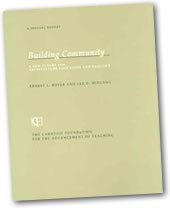
If you weren't fortunate enough to get a chance to read Building Community: A New Future for Architecture Education and Practice by Ernest L. Boyer and Lee D. Mitgang when it was first published seven years ago, consider today your lucky day. The book, published originally by the Carnegie Foundation for the Advancement of Teaching in 1996, has just been reprinted and is now available through the AIA Bookstore. Also known affectionately as the "Boyer Report" after one of its authors (who passed away shortly before the report was published), Building Community constitutes a 30-month exploration of "the problems, possibilities, and larger meaning for the education of architects."
 The
most oft-quoted line from Building Community
is: "Perhaps never in history have the talents, skills, the broad
vision and the ideals of the architecture profession been more urgently
needed." Under that premise, Building
Community has served as a compass for the advancement of the profession
and the education of its future members since it was published. And perhaps
never in the history of the profession has its insight been more needed.
The
most oft-quoted line from Building Community
is: "Perhaps never in history have the talents, skills, the broad
vision and the ideals of the architecture profession been more urgently
needed." Under that premise, Building
Community has served as a compass for the advancement of the profession
and the education of its future members since it was published. And perhaps
never in the history of the profession has its insight been more needed.
Building Community offers a framework for enhancing architecture education and practice via seven priorities:
1. An enriched mission: Preparing
architecture graduates not only to practice competently, but also to:
• Promote the value of beauty in society
• Connect buildings to human needs and happiness
• Create healthier, more environmentally sustainable architecture
that respects precious resources.
2. Diversity with dignity: Preserving and strengthening the multiple missions of architecture programs in ways that recognize and encourage the varied talents of faculty to achieve a balanced scholarship of research, teaching, application of knowledge, and integration of learning
3. Standards without standardization: Establishing a more coherent and widely known set of learning goals and standards for architecture students, faculty, and programs within a context that values and encourages program diversity
4. A connected curriculum: Providing more liberal, flexible, and integrated programs of study that fulfill the goals of professional competence in all schools while allowing students more freedom to explore the connection between architecture and other fields, as well as their individual learning and career goals
5. A climate for learning: Establishing a more humane learning environment—at all schools—that is open, just, communicative, celebratory, and caring
6. A more unified profession: Creating
a framework for improved collaboration between the academy and practice
based on:
• Improving the educational experience of students
• Providing more satisfying internships
• Promoting the importance of lifelong learning for all architects
7. Service to the nation: Encouraging schools to increase and make better known the storehouse of architecture knowledge to enrich communities and prepare all architects for lifelong civic engagement and highest ethical practice.
Wide-reaching touch
It is interesting to look at how these priorities have shaped the direction
of practice and education in the last seven years, notably through major
policy documents that include the AIA's multi-year Aligning
the Institute for the Millennium (AIM) strategic plan and the nine
Collateral Internship Task Force (CITF) recommendations. It is plain that
Building Community still serves
as a valid guide today. One can see its nudge toward collaboration in
current events such as last week's national
Solar Decathlon and Internship Summit.
In fact, the AIA presented a copy of the book to all participants at the
summit.
Building Community recommends itself through another major attribute: it is silkily written, rendering it an easy and enjoyable read. Its quiet optimism for the architecture profession steps lightly through every straightforward and forward-moving sentence. The authors offer us plenty of examples and quotes from architects and architecture students to make the words come alive. Anyone who attended architecture school will be transported back to the good, the bad, the ugly, and the beautiful of the experience. Finally, the authors do not sugar-coat the amount of work that could be done to improve architecture education and ultimately the profession. They simply make it an opportunity instead of a burden.
Copyright 2002 The American Institute of Architects. All rights reserved.
![]()
|
You can order Building Community from the AIA Bookstore, $13.50 AIA members/$15 retail (plus $6 shipping per order). Order online; phone 800-242-3837 option #4; or fax 202-626-7519. |
|